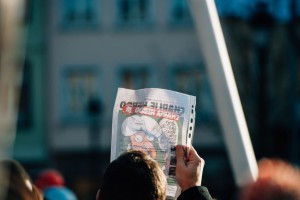Two Years after the Charlie Hebdo Massacre: Some Lessons for Resisting Extremism through Art and Humor

I’ll never forget the morning of January 7, 2015, when I came into the American Humanist Association to begin the workday. The atmosphere was subdued and a somber silence had fallen over the office. All of us had heard the news on our commutes—that there had been an attack on the French satirical magazine Charlie Hebdo and that a dozen people had been killed.
Despite the tragedy, people came together from all over the world to declare, “Je suis Charlie!” and show their support for the brave cartoonists who had defied Islamic extremists in daring to print images of their prophet Muhammad on the magazine’s cover. The message of solidarity was clear: art and satire may have the power to offend, but they also have the power to bring people together.
Now, with Americans only days away from President-elect Donald Trump’s inauguration and already under the thumb of a Republican-controlled Congress that’s threatening to destroy our healthcare, repeal important legislation protecting church-state separation, and spend billions of dollars on an unnecessary wall at the Mexican border, we find ourselves in a situation in which we may need more subversive art and satire to spread information. While we certainly need hard, honest news that does not shy away from the facts (or hide behind equivocations of “both sides do it”) in order to combat the spread of fake news in the digital age, we also need to craft messages that target people’s emotions.
While facts and figures can be difficult to recall, the feelings that art evokes often last long after the page is turned or the curtain drops. The point of satire remains with us long after the joke is finished. Art and satire possess vital power to challenge authority, which is why they pose such a serious danger to religious extremists, authoritarian politicians, and all others who wish to maintain the status quo from which they benefit. It’s also why art and satire have been the tools of social movements, as they convey the messages of the oppressed to the wider culture in ways that bypass other methods of communication.
While it isn’t quite fair to compare the oppressive might of Trump and Republicans to Islamic extremists in France, whose radicalization is in part to blame for the racism and distrust of Western culture, the boldness of Charlie Hebdo to court controversy, no matter what the cost, can serve as a source of inspiration for humanists in the United States during our own troubled times. Already, artists have been coming together to subvert the incoming Trump administration, and the humanist movement can join their efforts and be inspired by other artistic activists around the world. (Those non-artists among us can also march with the American Humanist Association at the Women’s March on Washington on January 21, 2017, starting at 8:30am.)
Women artists have come together to put on a Nasty Women art show to benefit Planned Parenthood, which is currently facing the prospect of having its federal funding cut. Artists and writers in New York recently held a candlelight vigil and march to Trump Hotel in the hopes of urging Ivanka Trump to speak out against her father’s racist, misogynistic, and homophobic rhetoric. Protest artists David Gleeson and Mary Mihelic spent the presidential campaign season traveling around the country in an ironic Trump bus, and after the election results, they may continue their satirical campaign. Even some Saudi women have created a catchy music video that mocks Trump, in addition to the harsh restrictions on women in Saudi Arabia.
Given Trump’s disturbing behavior at his first press conference since the election results, in which he accused CNN of distributing “fake news” and refused to take a reporter’s questions while later his press secretary threatened to throw the journalist out of the conference, the president-elect seems likely to continue the rancor against the media that he began in his campaign. Presumably, he will have similar distain for subversive art. Yet those who would stand against the approaching threats to church-state separation, women’s rights, LGBTQ equality, and racial justice, among many other important issues, must bravely do so to impart the truth, to subvert oppression, and to inspire others.
The staff at Charlie Hebdo knew two years ago, as they know today, that some consider their magazine dangerous enough to attack. Yet they continued to publish because their freedom of speech and expression was too important for them to give into self-censorship. We must draw inspiration from their courage, as well as the courage of other artists, to boldly express our truth.
